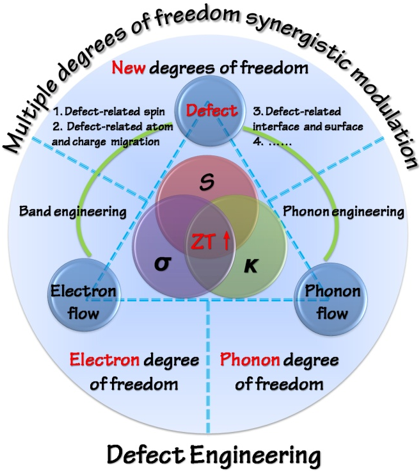Defect chemistry for thermoelectric materials: a multiple degrees of freedom synergistic modulation approach
Invited by the “Journal of the American Chemical Society”, Prof. XIE Yi and Prof. XIAO Chong’s group from Hefei National Laboratory for Physical Sciences at the Microscale (HFNL) and Collaborative Innovation Center of Chemistry for Energy Materials (2011•iChEM) in the University of Science and Technology of China (USTC) recently gave a Perspective article entitled with “Defect Chemistry for Thermoelectric Materials”. Based on the current defect engineering strategy in the field of thermoelectricity, this perspective review re-examined the issue of degree of freedom in defect modulation, and proposed the idea of “multiple degrees of freedom synergistic modulation” by combining the current established optimization strategies of tuning electronic and phonon structures with some additional modulation degrees of freedom caused by defect chemistry.
As a new type of clean energy material, thermoelectric materials can directly realize the reversible conversion between heat and electricity energy, which is expected to provide an optimized choice for improving the energy efficiency and alleviating the environmental pollution. However, an inconvenient truth is that, the energy conversion efficiency of thermoelectric devices has been hovering at a low level, which is attributed to the inverse relationship between the electrical and thermal transport parameters determined by the intrinsic electronic structure. Much time and effort has been invested in development of high-performance thermoelectric materials and a series of concepts and ideas have been proposed, among which defect engineering strategy plays the most important role. Defect engineering, at the core of the field of thermoelectric studies, serves as a scaffold for engineering the intrinsic electrons’ and phonons’ behaviors to tailor thermoelectric parameters through the direct impacts of band engineering and phonon engineering, which can modify electronic band structure and phonon transport behavior to enhance the power factor (PF = σS2) and reduce the lattice thermal conductivity (κl). By virtue of the implementation of defect engineering, the past decades have witnessed great progress in thermoelectric research through synergistic optimization of the intercorrelated transport parameters, and substantial enhancement has been achieved in the performance of various thermoelectric materials. However, current established optimization strategies based on defect engineering are mainly focused on tuning the electronic and phonon structures, while modulation by additional degrees of freedom caused by defects has long been neglected.

In this Perspective, Prof. XIE Yi and Prof. XIAO Chong’s group focus on the underexploited aspects of defect engineering, which include defect-related spin effects, defect-mediated atom or charge migration effects, and defect-related interface effects. Through these new points of view, the authors hope to arouse intense attention to the overlooked parts of defect engineering and combine them with current optimization strategies from the perspective of multiple degrees of freedom modulation, to enable the full potential of defect engineering for boosting thermoelectric performance.
This work was financially supported by National Basic Research Program of China, National Natural Science Foundation of China, the Youth Innovation Promotion Association CAS, the Key Laboratory of Neutron Physics, and the Fundamental Research Funds for the Central University.
Publication link: http://pubs.acs.org/doi/abs/10.1021/jacs.6b08748
QQ图片20161108155223.png
Back
